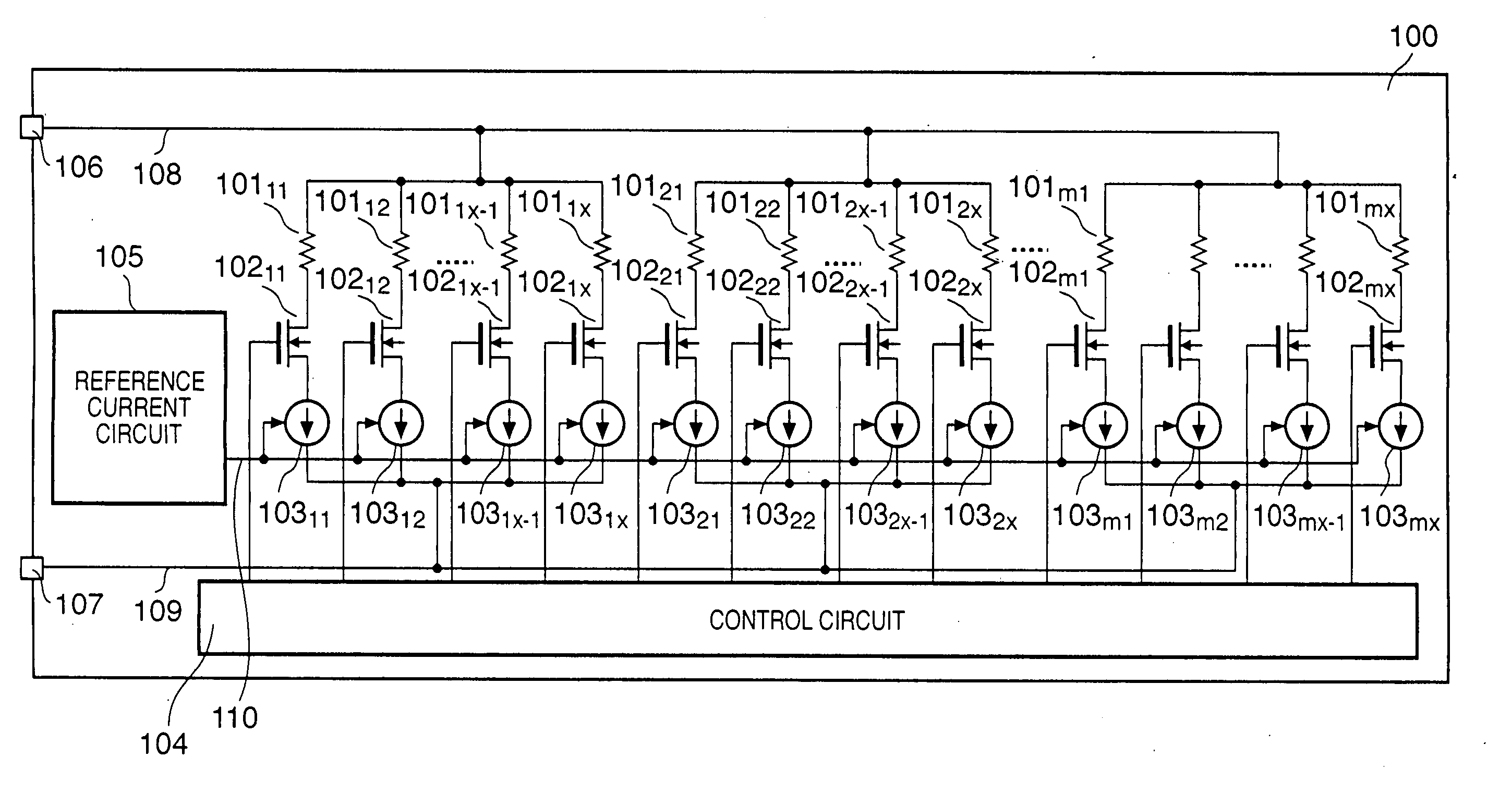Recording head and recorder comprising such recording head
a recording head and recording head technology, applied in printing and other directions, can solve the problems of limited current value which can be supplied at once, increased wiring resistance and resistance variations, limited power supply capacity of printer apparatus, etc., and achieve the effect of suppressing an increase in cost and stably recording at a high speed
- Summary
- Abstract
- Description
- Claims
- Application Information
AI Technical Summary
Benefits of technology
Problems solved by technology
Method used
Image
Examples
first embodiment
[0040]FIG. 1 is a circuit diagram for explaining the arrangement of a heater driving circuit mounted on the heater substrate of an inkjet printhead according to the first embodiment of the present invention.
[0041] In FIG. 1, reference numerals 10111 to 1011x denote heaters (heater resistors) for printing. A current is sent to each heater to generate heat, and a corresponding nozzle discharges an ink droplet. In the printhead using the heater substrate, orifices (nozzles) for discharging ink are arranged in correspondence with the respective heaters. The heaters 10111 to 1011x are divided into blocks 1 to m, and each block includes x heaters, and x NMOS transistors which are arranged in correspondence with the respective heaters. Reference numerals 10211 to 1021x denote NMOS transistors for ON / OFF-controlling energization to corresponding heaters. Reference numerals 10311 to 1031x denote constant current sources which are arranged in correspondence with the respective heaters. The c...
second embodiment
[0051]FIG. 4 is a circuit diagram showing an example in which the constant current source 103 of FIG. 1 according to the first embodiment is formed from NMOS transistors 40111 to 4011x. The same reference numerals as those in FIG. 1 denote the same parts, and a description thereof will be omitted.
[0052] The drains of the NMOS transistors 40111 to 4011x are respectively connected to the sources of switching NMOS transistors 10211 to 1021x. The gates of the NMOS transistors 40111 to 4011x receive a control signal 110 from a reference current circuit 105. Current values flowing through the respective heaters are controlled by the gate voltages of the NMOS transistors 40111 to 4011x which are controlled by the control signal 110 from the reference current circuit 105.
[0053] The operation of the NMOS transistors 40111 to 4011x in FIG. 4 will be explained with reference to FIGS. 5 and 6.
[0054]FIG. 5 is a graph showing an example of the general static characteristic of an NMOS transisto...
third embodiment
[0056]FIG. 7 is a circuit diagram showing an example in which the sources of NMOS transistors 70111 to 7011x are connected to the drains of the NMOS transistors 40111 to 4011x shown in FIG. 4, and two corresponding NMOS transistors are cascade-connected in series to form a constant current source 203 (FIG. 2). The same reference numerals as those in FIGS. 1 and 4 denote the same parts, and a description thereof will be omitted. The third embodiment will explain a structure of two transistors, but the present invention can also be applied to a structure of a larger number of transistors.
[0057] The gates of the NMOS transistors 70111 to 7011x are also connected to a reference current circuit 105. The NMOS transistors 70111 to 7011x operate as grounded-gate transistors, and fix the drain voltages of the NMOS transistors 40111 to 4011x on the basis of the potentials between the gates and sources of the NMOSs 70111 to 7011x. In this case, the reference current circuit 105 sets the gate ...
PUM
 Login to View More
Login to View More Abstract
Description
Claims
Application Information
 Login to View More
Login to View More - R&D
- Intellectual Property
- Life Sciences
- Materials
- Tech Scout
- Unparalleled Data Quality
- Higher Quality Content
- 60% Fewer Hallucinations
Browse by: Latest US Patents, China's latest patents, Technical Efficacy Thesaurus, Application Domain, Technology Topic, Popular Technical Reports.
© 2025 PatSnap. All rights reserved.Legal|Privacy policy|Modern Slavery Act Transparency Statement|Sitemap|About US| Contact US: help@patsnap.com



